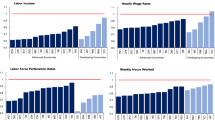Abstract
Corina Rodríguez Enríquez and Diane Elson argue that the aim to build strong, efficient and more equitable tax system should become a goal for feminism. They propose a framework for analyzing taxation using a gender equality lens that could shape a fair and equitable taxation system.
Similar content being viewed by others
Notes
For a key article on the social content of macroeconomics policies, see Elson and Cagatay (2000).
It should be noticed, as Valodia (2010: 308) explains, that ‘these results may be sensitive to the fact that the incidence analysis is conducted on expenditure. In Mexico, (…) the incidence analysis on income suggested some different trends. In particular, Mexican households in which most income is earned by women have a higher indirect tax incidence than households where men earn most income. Incidence is lowest in households where men and women earn similar incomes’.
Egalitarian households would be those where there is parity in male and female members participation in paid and unpaid work, as well as fair access and control over economic resources.
References
Bahl, Roy W. and Richard M. Bird (2008) ‘Tax Policy in Developing Countries: Looking back and forward’, National Tax Journal LXI (2): 279–301.
De Villota, Paloma (2003) ‘Aproximación desde una perspectiva de género a la política presupuestaria desde la vertiente impositiva. El caso de España’, in Paloma de Villota (ed.) Economía y Género. Macroeconomía, política fiscal y liberalización. Análisis de su impacto sobre las mujeres, Barcelona: Icaria Editorial.
Elson, Diane (2006) Budgeting for Women's Rights: Monitoring government budgets for compliance with CEDAW, New York: UNIFEM.
Elson, Diane and Nilufer Cagatay (2000) ‘The Social Content of Macroeconomic Policies’, World Development 28 (7): 1347–1364.
Grown, Caren (2010) ‘Taxation and Gender Equity. A conceptual framework’, in Caren Grown and Imraan Valodia (eds.) Taxation and Gender Equity. A comparative analysis of direct and indirect taxes in developing and developed countries, New York: Routledge.
Himmelweit, Sue (2002) ‘Making Visible the Hidden Economy: The case for gender-impact analysis of economic policy’, Feminist Economics 8 (1): 49–70.
Nelson, Julie (1996) Feminism, Objectivity and Economics, New York: Routledge.
Pazos Morán, Maria, (dir.) and Maribel Rodríguez (coord.) (2010) Fiscalidad y equidad de género, Madrid: Fundación Carolina – CeALCI.
Stotsky, Janet (1997) ‘Gender Bias in Tax Systems’, Tax Notes International 9: 1913–1923.
Valodia, Imraan (2010) ‘Conclusion and Policy Recommendations’, in Caren Grown and Imraan Valodia (eds.) Taxation and Gender Equity. A comparative analysis of direct and indirect taxes in developing and developed countries, New York: Routledge.
Additional information
Sets out new ideas around tax that would support women's well-being
Rights and permissions
About this article
Cite this article
Enríquez, C., Elson, D. Taxing for Gendered Economic Justice. Development 55, 299–304 (2012). https://doi.org/10.1057/dev.2012.31
Published:
Issue Date:
DOI: https://doi.org/10.1057/dev.2012.31




